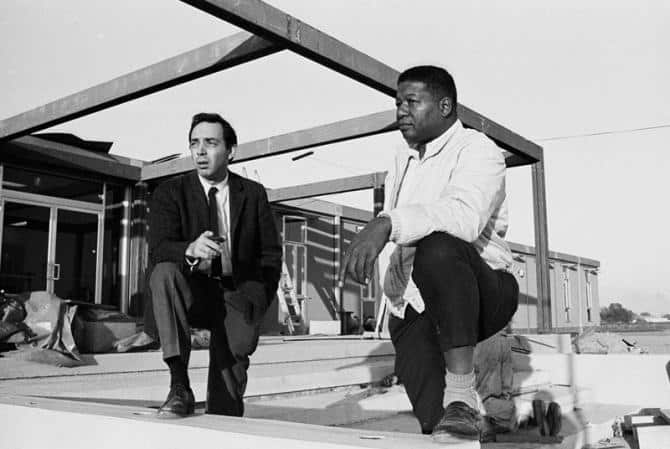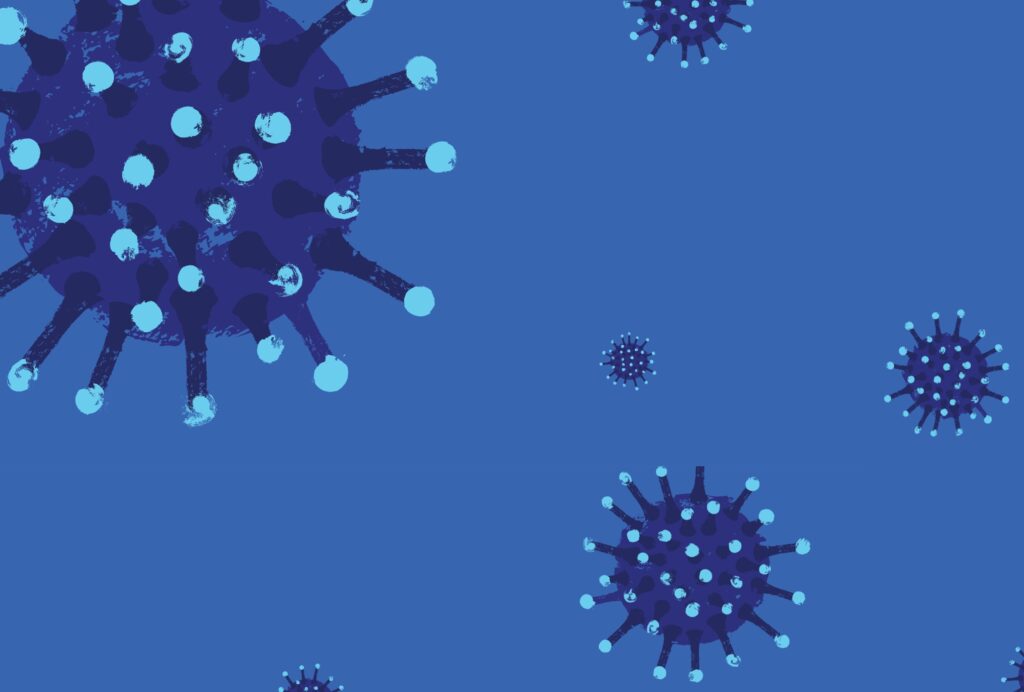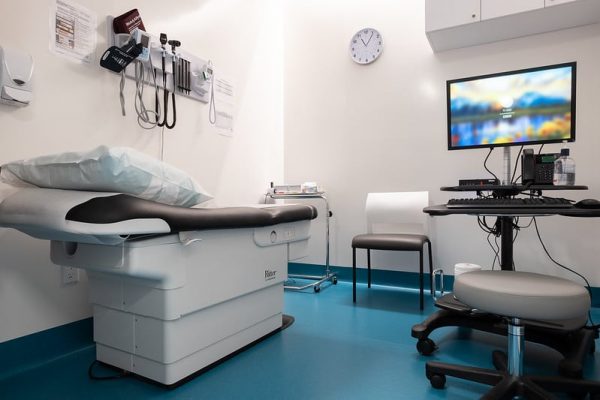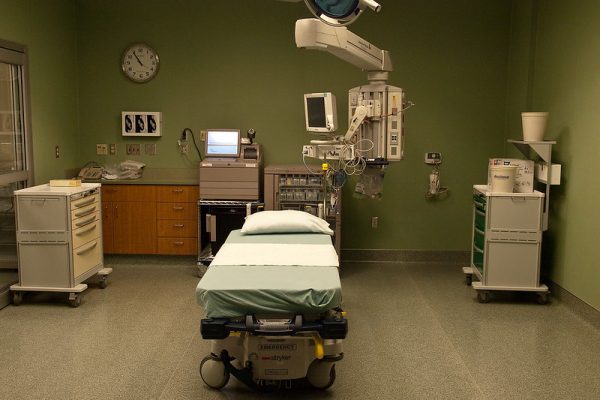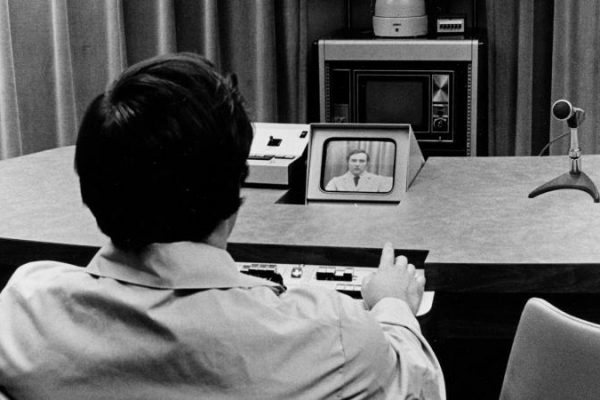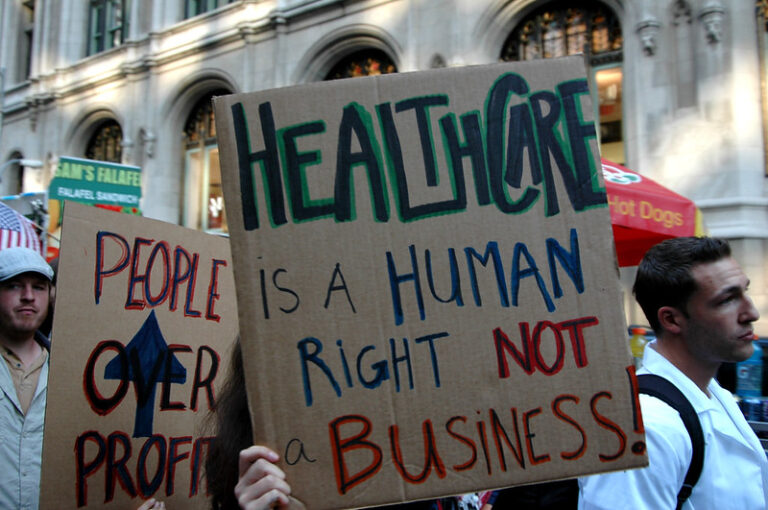Inflamed: Deep Medicine and the Anatomy of Injustice
Rupa Marya and Raj Patel
Farrar, Straus and Giroux, $30 (cloth)
A parable often told in public health circles compares the work of medical providers to rescuers standing on the side of a river. We see a person struggling in the rapids and jump in to save them; then we see another and rescue them—and then another, and then another. We are too busy pulling people out to stop and question why they are falling into the river in the first place.
A new book by physician-activist Rupa Marya and researcher-journalist Raj Patel, Inflamed: Deep Medicine and the Anatomy of Injustice, shows us exactly why so many are drowning. During my twenty-five years of practice as a family medicine physician, I have often felt like I am pulling people out of that proverbial river, resuscitating them, drying them off a bit, maybe giving them a short pep talk about how to swim, then pushing them right back into the same toxic mix of racism, inequality, and pollution—the poisonous brew the authors describe as “colonial capitalism.”
Inflamed exposes, in exquisite detail, how the for-profit Western medical model is woefully inadequate in addressing our modern health problems, most of which have their roots in our unhealthy social, cultural, and physical environment rather than individual genetics or biology. The book centers on the theme of inflammation as both a literal biological process and a metaphor for social failures, explaining how the effects of injustice and human-caused environmental degradation play out in our bodies and create illness. Our bodies are inflamed, the authors show, because our society is inflamed. Anyone who has worked in health care, especially during the pandemic, feels this acutely. We see it every day in our patients and in ourselves.
Had I read Inflamed before I started medical school, I might have chosen another career. In a line that particularly stung, the authors observe that “practitioners of modern medicine are not trained to be healers. They are trained to be biomedical technicians.” The truth hurts. Most of us went to nursing or medical school to be healers. We are so stressed precisely because we find ourselves in a role akin to widget-makers, producing a product for profit. The product isn’t wellness or health but a billable code, a pill or procedure that can be charged to the patient or an insurance company.
Even before the pandemic, health care workers were experiencing high rates of anxiety and burnout. Primary care physicians, especially, feel as if we have been turned into clerical workers, with many more hours spent staring at computer screens and ticking off boxes than spent listening to and examining patients. We are pressured to fit so many visits into a day that we can only spend a few minutes with each person we see, leaving both the physician and patient frustrated.
Indeed, Marya and Patel cite studies showing that most physicians don’t even pause to ask patients what they would like out of the medical visit and that the average time a provider listens to a patient speak before interrupting is only eleven seconds. Medical schools neglect the teaching of listening skills and trust-building with patients in favor of making students memorize complicated biochemical reactions we’ll never need in practice. Increasingly, the authors note, “the primary focus of the doctor’s gaze is the screen on which they transcribe and code the record of symptoms.” Both patients and providers want more, yet our profit-driven health care system has vanishingly little space for building meaningful healing relationships. This situation is at the heart of the ills Inflamed deftly diagnoses. It also explains where the book’s prescriptions may ultimately fall short.
In a sweeping global survey, Marya and Patel illustrate how colonial capitalism affects us all in both obvious and less visible ways. The book takes us on a journey that mirrors the structure of the first years of medical school, when students learn the anatomy and pathology of the human body system by system. The result is a sort of rollercoaster tour of social medicine, dipping down into the minutiae of biology, history, sociology, or economics and then zooming out again to explain how global forces play out in our individual lives. The authors expertly dissect the many aspects of our toxic environment to explain the exact pathways that cause inflammation in our bodies and lead to chronic illness and shortened lifespans.
The chapter on the digestive system, for example, highlights the importance of the microbiome: the vast collection of microbes with which we share our tissues. Over the last decade these fellow travelers have become a very active area of medical research—a story told by science writer Ed Yong in his 2016 book I Contain Multitudes: The Microbes Within Us and a Grander View of Life and now detailed in Alessio Fasano and Susie Flaherty’s new book Gut Feelings: The Microbiome and Our Health. Some estimates find that cells of our non-human companions outnumber our human cells by ten to one. Since a national collaborative research initiative, the Human Microbiome Project, was launched in 2007, we have learned that the microbiome affects almost all aspects of our health and well-being, including how we process food, the functioning of our immune system, the way respond to certain medications and treatments, and even our moods, sleep patterns, and stress levels.
In his 2011 book, The Wild Life of Our Bodies: Predators, Parasites, and Partners That Shape Who We Are Today, biologist Rob Dunn explains that the germ theory of infectious disease only tells half the story. Not all microbes are disease-causing pathogens to be combated and eradicated; many—perhaps most—are essential for our survival. We evolved together, in a kind of symbiotic co-dependence, with thousands of different bacteria, protozoa, viruses and even parasites. Our bodies themselves are ecosystems, Marya and Patel explain, in communication with the larger concentric biomes we inhabit, and it is impossible for our internal ecosystem to be healthy when our external environment is sick and suffering.
Marya and Patel carefully catalog all the insults to the ecosystems we depend on, from contamination with endocrine disrupters like pesticides and antibiotics, to diets that are “rich in industrial chemicals that currently flood our food system,” and to capitalist agricultural practices that result in pollution of our air and water and depletion of the soil. The chapter on the endocrine system gives several examples, including the family of chemicals known as perfluoroalkyl substances (PFAS), which are found in everything from textiles to firefighting foam. Even though production in the United States was mostly halted in the early 2000s, the Centers for Disease Control estimates that PFAS exposure is widespread. The substances are known as “forever chemicals” because they never degrade, accumulating in our environment and our bodies over time. They are commonly found in the food and water supply and have been linked to cancers, thyroid disease, high cholesterol, ulcerative colitis, and birth defects.
Even the stress that results from childhood traumas, or from a lifetime spent experiencing racism and inequality, causes inflammation that results in chronic disease and alters the genetic code. In this way, oppression and violence suffered by one generation is passed down in the form of illness to children and grandchildren. “What makes a healthy microbiome is as complex a question as what makes a healthy forest,” Marya and Patel conclude. Yet medical schools persist in teaching “reductionist models of disease,” rather than the more complex and expansive view that considers our interactions with the whole environment.
In many instances, the authors describe a healthier past disrupted by capitalism and colonization, and then they connect the dots to our present society and state of health. The end of the digestive system chapter, for example, discusses the colonization of Okinawa. The island has more residents over one hundred years old than almost anywhere else on the globe, earning it the “blue zone” designation—a name given to a few places on earth where many people seem to live inordinately long, happy, and healthy lives. After World War II, Americans were welcomed and seen as liberators after oppressive Japanese rule, and Okinawa remained under U.S. control until 1972. During that span, the U.S. military set up several bases and imported thousands of troops, along with all the trappings of American lifestyle and cuisine.
As a result, thousands of Okinawans were displaced from their land and their traditional way of life. The amount of fat in the Okinawan diet went from 10 percent in 1960 to over 30 percent today. Now Okinawans have the highest obesity rates in all of Japan, and not coincidentally, a rising mortality rate among younger adults as well as falling life expectancies overall. The effects of successive waves of colonization, first from the Japanese and then from Americans, have eroded the very aspects of the Okinawan diet and culture that created the conditions making long healthy lives of its centenarians possible.
These contributions make Inflamed required reading. But although it succeeds at describing myriad injustices, the book ultimately falls short in fully explaining what practicing “deep medicine” should mean and how we can create a health care system that delivers it.
“Deep medicine,” Marya and Patel write, is “a practice that any healer can begin immediately. It starts with the act of repairing those relationships that have been damaged through systems of domination.” But as healers forced to be “biomedical technicians,” we quickly find that in our current system it is incredibly difficult to practice this way—repairing relationships one by one—without sacrificing our own well-being. Where is the space for relationship building when we are told we must see twenty-five patients or more a day just to cover costs, when electronic medical records are designed to capture all the billables rather than facilitate patient care, and when we are forced to spend hours arguing with insurance companies to get our patients the care they need? Although Inflamed acknowledges that structural change is necessary, the authors’ most specific directives are aimed at individuals. When they call for systemic action, Marya and Patel tend to fall back on vague policy prescriptions to fix our crumbling system of care.
The COVID-19 pandemic has brought all of these failings into even sharper relief for those of us on both sides of the exam table. Throughout the pandemic we have seen the consequences of the lack of trust in our public health leaders. The refusal to wear masks or follow social distancing directives cost many thousands of lives. Skepticism about vaccinations has delayed our emergence from the crisis and cost thousands more. In 1966 more than three-quarters of Americans had “great confidence” in medical leaders; now only 34 percent do. Only a quarter of Americans today say they have faith in the health care system as a whole.
Most disturbingly, the profit-driven aspects of Western health care that frustrate doctors and nurses are also causing patients to lose faith in the entire system. How do we regain the trust of patients who rightly wonder if we are more focused on profit than healing? The vast and corrupting influence of money in health care is impossible to deny, from insurance companies to big pharma. As Marcia Angell, former editor-in-chief of the New England Journal of Medicine, noted in these pages over a decade ago:
The major drug companies are now hugely profitable, with net incomes consistently several times the median for Fortune 500 companies. In fact, they make more in profits than they spend on research and development (R&D), despite their rhetoric about high prices being necessary to cover their research costs. (They also spend twice as much on marketing and administration as they do on R&D.)
Indeed, study after study shows that both patients and doctors are easily swayed by slick ads slanted to make it appear that a new expensive drug is much better than older, cheaper one, even if the evidence of advantage is weak. We question if our medical experts’ advice is based solely on the science, or if the influence of money and profit are also shaping recommendations and policy.
In response to these deep fault lines, Marya and Patel reiterate the calls of many other activists for desperately needed policies, including access to health care for all. But even if we finally enact some form of universal health care, it will remain embedded in a fundamentally capitalist system defined by profit and cost-effectiveness—for hospitals, for doctors, and for drug and insurance companies—rather than by compassion and healing. The authors thus recognize that broad collective action is necessary to bring about the social and political changes they prescribe. To begin this work, they ask that we practice fugitivity, abolition, and solidarity—to decolonize our health system by creating “communities of care.” As they put it:
Fugitivity requires direct action to evade the structures and logic that have come with liberal settler colonialism. It calls for escaping the bounds of the state and its colonial institutions, from the hospital and the university to the prison and the military, and weaving political communities dedicated to healing together.
As someone who fled academia and hospitals to work in a community clinic, I think this is exactly right. Abolition, the authors note, is not a “negative rejection” but a “positive embrace” of new institutions and practices to replace our failed prisons, military, private corporations, and for-profit health care. And as part of this work, the authors ask for greater solidarity in listening to and supporting movements led by Indigenous and colonized people.
While these are certainly essential prescriptions, they need to be tied to concrete practices and collective organizing in order to make a meaningful difference. On this front, the book misses an opportunity to reflect on efforts to make “deep medicine” a reality and the obstacles we continue to face today in bringing better health care to all. For my entire career I have tried to do what Marya and Patel suggest. I am far from alone. Several efforts, both in the United States and globally, have attempted to redefine and remake the Western medical model into a system that provides true healing to everyone, especially those who have suffered most at the hands of colonial capitalism.
One particularly significant example is the Health for All movement pioneered by the World Health Organization (WHO) in the late 1970s. A watershed moment came in 1978, when the WHO’s Director-General, Halfdan Mahler, convened the Alma-Ata International Conference on Primary Health Care in Kazakhstan, bringing together 3,000 delegates from 134 national governments and 67 international organizations. As Susan B. Rifkin describes, the Declaration of Alma-Ata, released in 1978, “broadened the perception of health beyond doctors and hospitals to social determinants and social justice.” The document called for “health for all the people of the world by the year 2000” and recognized that health—meaning “a state of complete physical, mental and social well-being”—is a human right.
The Alma-Ata Declaration also condemned the “gross inequality in health status of the people.” The solutions proposed by the Alma-Ata attendees and the WHO completely reimagined how health care should be delivered, recommending that care be based in communities rather than hospitals and that focus be shifted from specialists to comprehensive primary care, accessible to all. This new concept of primary health care had several components: health promotion and education; preventive, curative, rehabilitative, and palliative care; and attention to the social determinants of health including safe water, a reliable and healthy supply of food, basic sanitation, and housing. Control was to be firmly rooted in the community, with integration of all cadres of health workers, from physicians to community health workers and traditional healers.
In his address to the delegates, Mahler asked: “Are you ready to introduce, if necessary, radical changes in the existing health delivery system so that it properly supports primary health care as the overriding health priority?” And also: “Are you ready to fight the political and technical battles required to overcome any social and economic obstacles and professional resistance to the universal introduction of primary health care?” His exhortations were powerful and necessary, but the declaration was quickly condemned for being too idealistic, expensive, and unrealistic. The following year, in 1979, the Rockefeller Foundation convened a competing conference in Bellagio, Italy. The result was a watered down, more cost-effective concept of “selective primary care,” which narrowed the focus to just the most prevalent diseases and specified a package of “low-cost technical interventions” to tackle them. Today we still see primary care deprioritized and devalued in health care systems throughout the globe.
A decade earlier, in the midst of the civil rights movement, pioneering physicians and social medicine activists H. Jack Geiger, John Hatch, and Count Gibson were already working to bring comprehensive primary care to the United States. They imported the idea of community-based health care, actively centered on solidarity, from a clinic in the South African township of Pholela, where Geiger, then a professor at Tufts University, had worked in 1957 as a medical student. Using this model and embodying the spirit of Alma-Ata, they launched what became known as the community health center movement. In Judy Schader Rogers’s powerful documentary Out in the Rural (1970), Geiger had this to say about their vision for the first such center in Mound Bayou, Mississippi, which opened in 1967:
What kind of a place are we? I think we’re a place that has as its primary thesis that the determinants of health are in the social order, not in health care. I’ve never seen any use in . . . the idea that you stand around in whatever circumstances, laying hands on people in the traditional medical way—waiting until they’re sick, curing them—and then sending them back unchanged into an environment that overwhelmingly determines that they’re going to get sick.
He too was tired of pushing people back into the toxic river. The revolutionary idea was that these health centers—deeply embedded in the community—would not just cure diseases but also treat the root causes of illness, from poor access to healthy foods to lack of education, housing, and employment. After securing grants from Tufts and Lyndon Johnson’s Office of Economic Opportunity, Geiger, Hatch, and Gibson did more than just build a clinic in an area without reliable access to health care: they also dug wells and established a library, farm cooperative, and office of education. When his patients were malnourished, Geiger wrote prescriptions for food, to be purchased at local, Black-owned grocery stores and paid out of the pharmacy’s budget. “The last time I looked in my medical textbooks,” he told a federal official after the governor complained, “they said the specific therapy for malnutrition was food.”
The Mississippi center still exists today. (Its history is told in Thomas J. Ward, Jr.’s recent book Out in the Rural (2016), borrowing the title of Rogers’s documentary.) Along with another pilot center launched in Boston, it has grown into a network of over 1,300 federally supported clinics serving 28 million patients of all backgrounds and income levels—all focused on providing excellent primary care to those who need it most, regardless of their ability to pay. The federal government requires community health center boards to reflect the demographic make-up of their communities; at least half the board of has to be made up of current patients.
Neither Alma-Ata nor the community health center movements are mentioned in Inflamed, but they were massive efforts to redefine health care—to practice the fugitivity and solidarity, along with the positively focused abolition, Marya and Patel want to see. (Many other examples of such work, including an essay by Geiger describing his journey to establishing the first community health centers, can be found in the 2013 essay collection Comrades in Health: U.S. Health Internationalists, Abroad and at Home.) Their successes, as well as their limitations, hold important lessons for any effort to pursue radical health care reform today.
Early in my career, I recognized that community health centers were the only places in the United States where I could practice the kind of “deep medicine” envisioned by so many over the years, so I joined the movement. I’ve worked in community health centers ever since, and for nearly a decade I’ve been the medical director of La Familia Medical Center, in Santa Fe, New Mexico, founded almost fifty years ago.
Not surprisingly, the past two years have been the most difficult of my career. I have learned that even with federally subsidies, it is exceedingly difficult to create a “sustainable model” in a for-profit medical system when a third of our patients are uninsured. Most of the work we do to ensure our patients can even access care—the work of addressing the so-called “social determinants of heath”—is not reimbursed by our current model of health care financing. If we want to support the kinds of programs imagined by the founders of the community health center movement, we have to constantly hustle for grants or fundraise from donors.
In our health center, we all want to practice the “deep medicine” that Inflamed envisions. We try to squash the health care hierarchy that always places doctors at the top by employing all cadres of health care workers—including community health workers, midwives, lactation consultants, nutritionists, diabetes educators, counselors, and case managers—and by striving to treat all our colleagues with dignity and respect. We try to give providers more time with patients, as well as generous paid time off and sick leave for all our staff. As a result, we can’t afford to pay our doctors and nurses as much as they would make elsewhere, and it is difficult to recruit physicians when the average debt upon graduating medical school is almost $250,000.
COVID-19 has introduced another layer of challenges for our clinics, from staff shortages to death threats from anti-vaxxers, and even a lawsuit from a woman who refused to wear a mask. We are faced with the tough decision to protect our staff by putting thousands of dollars into security and lawyers instead of programs for patients or raises for staff. The stress is so intense and health care workers are so exhausted and burned out that, according to recent surveys, around half of us are considering leaving the profession entirely. Our entire health care system seems to be crumbling under the burden of the pandemic. There has never been more urgency to find a better way.
In this context, Inflamed’s rich portrait of the anatomy of injustice should be assigned to every pre-med, medical, and nursing student. Almost none of this content is mentioned in medical schools, beyond a few hours of instruction on health disparities. At the same time, it is important to recognize what the book misses in the solutions it proposes. More than conceptual suggestions, we need practical models and effective organizing for collectively remaking our systems of care.
In short, the idea of “deep medicine” is not new, and any clear-eyed movement for health justice today must begin by acknowledging what has kept it from becoming more widespread. Many of us have been striving to practice this way for decades. I believe we can make it the standard, rather than the fugitive practice of a small minority, but it will take revolutionary collective action to completely retool the Western medical model. Many more people must begin acting out of the solidarity that Inflamed calls for if we are to achieve abolition of the dysfunctional parts of our health care system. And maybe, if more people learn about the roots of injustice, as well as the possibility of different models of health care that center healing, we might be inspired to bring about that desperately needed revolution.
